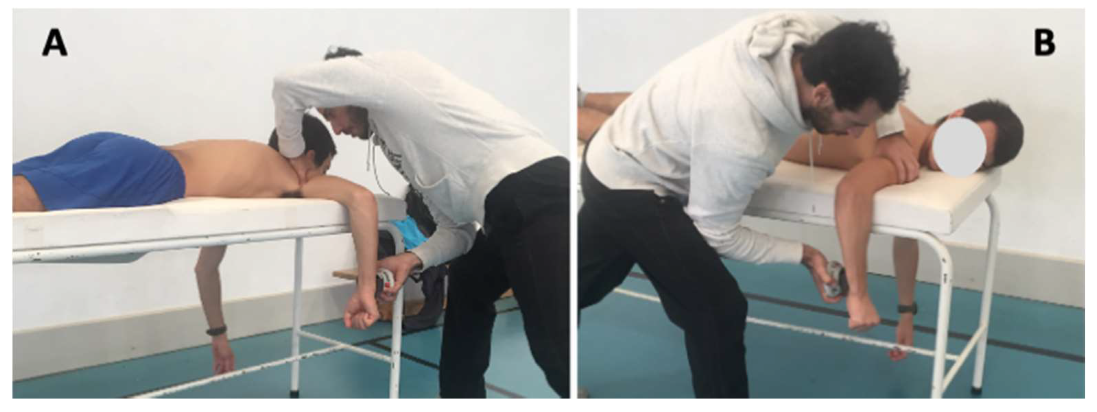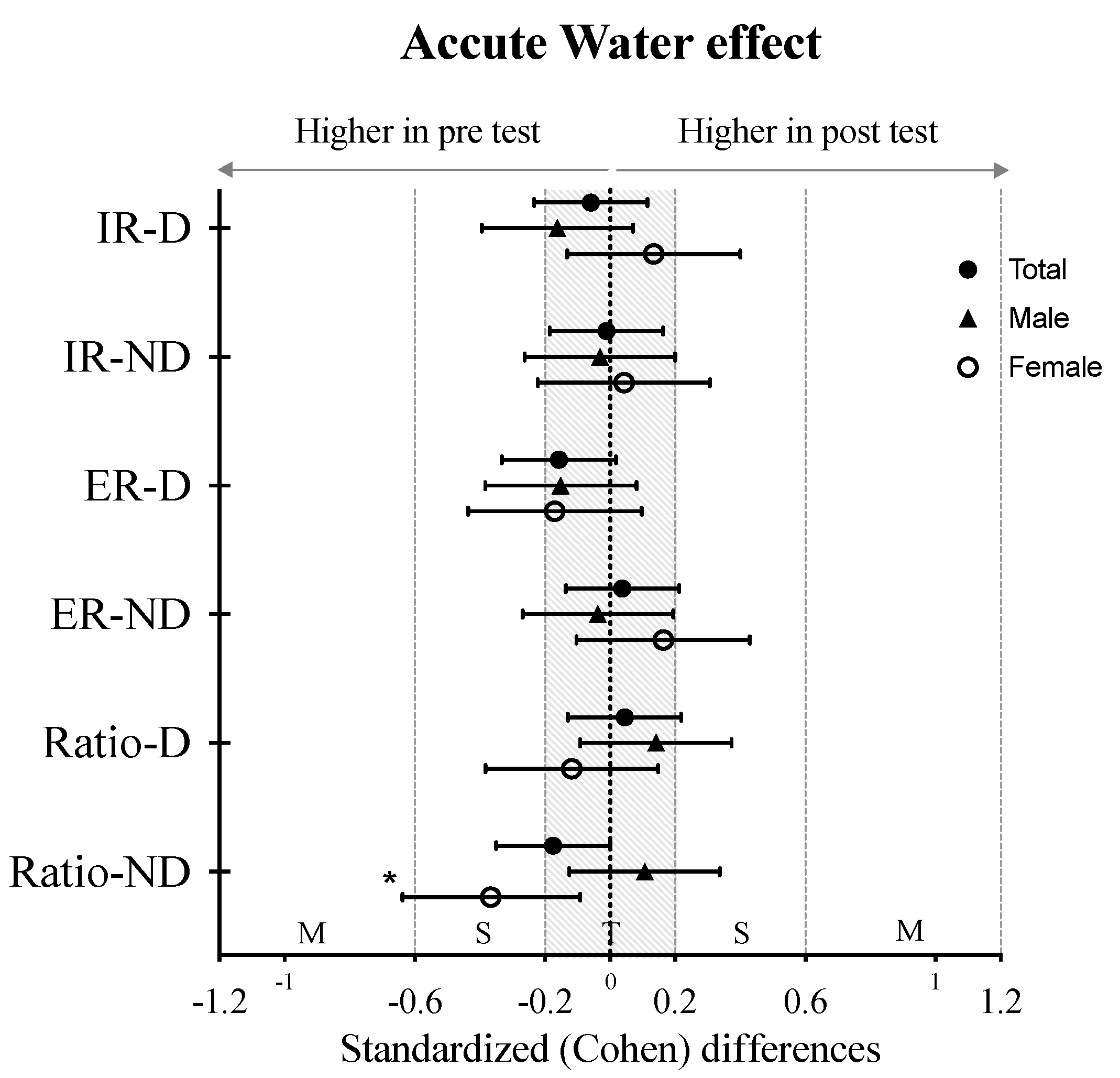The Acute Effects of a Swimming Session on the Shoulder Rotators Strength and Balance of Age Group Swimmers
Abstract
:1. Introduction
2. Materials and Methods
2.1. Participants
2.2. Procedures
2.3. Statistical Analysis
3. Results
4. Discussion
5. Conclusions
Author Contributions
Funding
Institutional Review Board Statement
Informed Consent Statement
Data Availability Statement
Acknowledgments
Conflicts of Interest
References
- Boettcher, C.E.; Cathers, I.; Ginn, K.A. The role of shoulder muscles is task specific. J. Sci. Med. Sport 2010, 13, 651–656. [Google Scholar] [CrossRef] [PubMed]
- Kluemper, M.; Uhl, T.; Hazelrigg, H. Effect of stretching and strengthening shoulder muscles on forward shoulder posture in competitive swimmers. J. Sport Rehabil. 2006, 15, 58–70. [Google Scholar] [CrossRef]
- Sawdon-Bea, J.; Benson, J. The Effects of a 6-Week Dry Land Exercise Program for High School Swimmers. J. Phys. Educ. Sports Manag. 2015, 2, 1–17. [Google Scholar] [CrossRef] [Green Version]
- Batalha, N.M.; Raimundo, A.M.; Tomas-Carus, P.; Marques, M.A.; Silva, A.J. Does an in-season detraining period affect the shoulder rotator cuff strength and balance of young swimmers? J. Strength Cond. Res. 2014, 28, 2054–2062. [Google Scholar] [CrossRef] [PubMed] [Green Version]
- Feijen, S.; Tate, A.; Kuppens, K.; Claes, A.; Struyf, F. Swim-Training Volume and Shoulder Pain Across the Life Span of the Competitive Swimmer: A Systematic Review. J. Athl. Train. 2020, 55, 32–41. [Google Scholar] [CrossRef] [Green Version]
- Byram, I.R.; Bushnell, B.D.; Dugger, K.; Charron, K.; Harrell, F.E.; Noonan, T.J. Preseason Shoulder Strength Measurements in Professional Baseball Pitchers Identifying Players at Risk for Injury. Am. J. Sports Med. 2010, 38, 1375–1382. [Google Scholar] [CrossRef]
- Batalha, N.; Marmeleira, J.; Garrido, N.; Silva, A.J. Does a water-training macrocycle really create imbalances in swimmers’ shoulder rotator muscles? Eur. J. Sport Sci. 2015, 15, 167–172. [Google Scholar] [CrossRef] [PubMed] [Green Version]
- Batalha, N.; Dias, S.; Marinho, D.A.; Parraca, J.A. The Effectiveness of Land and Water Based Resistance Training on Shoulder Rotator Cuff Strength and Balance of Youth Swimmers. J. Hum. Kinet. 2018, 62, 91–102. [Google Scholar] [CrossRef] [Green Version]
- Batalha, N.; Paixao, C.; Silva, A.J.; Costa, M.J.; Mullen, J.; Barbosa, T.M. The Effectiveness of a Dry-Land Shoulder Rotators Strength Training Program in Injury Prevention in Competitive Swimmers. J. Hum. Kinet. 2020, 71, 11–20. [Google Scholar] [CrossRef] [PubMed] [Green Version]
- Roy, J.S.; Ma, B.; Macdermid, J.C.; Woodhouse, L.J. Shoulder muscle endurance: The development of a standardized and reliable protocol. Sports Med. Arthrosc. Rehabil. Ther. Technol. 2011, 3, 1–14. [Google Scholar] [CrossRef] [Green Version]
- Ebaugh, D.D.; McClure, P.W.; Karduna, A.R. Effects of shoulder muscle fatigue caused by repetitive overhead activities on scapulothoracic and glenohumeral kinematics. J. Electromyogr. Kinesiol. 2006, 16, 224–235. [Google Scholar] [CrossRef]
- Conceicao, A.; Parraca, J.; Marinho, D.; Costa, M.; Louro, H.; Silva, A.; Batalha, N. Assessment of isometric strength of the shoulder rotators in swimmers using a handheld dynamometer: A reliability study. Acta Bioeng. Biomech. 2018, 20, 113–119. [Google Scholar] [CrossRef]
- Cools, A.M.J.; Vanderstukken, F.; Vereecken, F.; Duprez, M.; Heyman, K.; Goethals, N.; Johansson, F. Eccentric and isometric shoulder rotator cuff strength testing using a hand-held dynamometer: Reference values for overhead athletes. Knee Surg. Sports Traumatol. Arthrosc. 2016, 24, 3838–3847. [Google Scholar] [CrossRef] [PubMed]
- Riemann, B.L.; Davies, G.J.; Ludwig, L.; Gardenhour, H. Hand-held dynamometer testing of the internal and external rotator musculature based on selected positions to establish normative data and unilateral ratios. J. Shoulder Elb. Surg. 2010, 19, 1175–1183. [Google Scholar] [CrossRef] [PubMed]
- Ramsi, M.; Swanik, K.A.; Swanik, C.B.; Straub, S.; Mattacola, C. Shoulder-rotator strength of high school swimmers over the course of a competitive season. J. Sport Rehabil. 2004, 13, 9–18. [Google Scholar] [CrossRef]
- Wang, H.K.; Cochrane, T. Mobility impairment, muscle imbalance, muscle weakness, scapular asymmetry and shoulder injury in elite volleyball athletes. J. Sports Med. Phys. Fit. 2001, 41, 403–410. [Google Scholar]
- Marinho, D.; Machado, J.; Silva, A. Política Desportiva FPN–Natação Pura. Identificação E Desenvolvimento Do Talento Em Natação; Federação Portuguesa de Natação: Lisboa, Portugal, 2020. [Google Scholar]
- Cohen, J. Statistical Power Analysis for the Behavioral-Sciences, 2nd ed.; Academic Press: New York, NY, USA, 1988. [Google Scholar]
- Pontaga, I. Shoulder external/internal rotation peak torques ratio side-asymmetry, mean work and power ratios balance worsening due to different fatigue resistance of the rotator muscles in male handball players. MLTJ 2018, 8, 513–519. [Google Scholar] [CrossRef] [Green Version]
- Forthomme, B.; Dvir, Z.; Crielaard, J.M.; Croisier, J.L. Isokinetic assessment of the shoulder rotators: A study of optimal test position. Clin. Physiol. Funct. Imaging 2011, 31, 227–232. [Google Scholar] [CrossRef]
- Dark, A.; Ginn, K.A.; Halaki, M. Shoulder muscle recruitment patterns during commonly used rotator cuff exercises: An electromyographic study. Phys. Ther. 2007, 87, 1039–1046. [Google Scholar] [CrossRef] [Green Version]
- Stackhouse, S.K.; Stapleton, M.R.; Wagner, D.A.; McClure, P.W. Voluntary activation of the infraspinatus muscle in nonfatigued and fatigued states. J. Shoulder Elb. Surg. 2010, 19, 224–229. [Google Scholar] [CrossRef] [PubMed]
- Ellenbecker, T.S.; Roetert, E.P. Testing isokinetic muscular fatigue of shoulder internal and external rotation in elite junior tennis players. J. Orthop. Sports Phys. Ther. 1999, 29, 275–281. [Google Scholar] [CrossRef] [PubMed] [Green Version]
- Yoma, M.; Herrington, L.; Mackenzie, T.A.; Almond, T.A. Training Intensity and Shoulder Musculoskeletal Physical Quality Responses in Competitive Swimmers. J. Athl. Train. 2021, 56, 54–63. [Google Scholar] [CrossRef] [PubMed]
- Pink, M.; Perry, J.; Browne, A.; Scovazzo, M.L.; Kerrigan, J. The normal shoulder during freestyle swimming. An electromyographic and cinematographic analysis of twelve muscles. Am. J. Sports Med. 1991, 19, 569–576. [Google Scholar] [CrossRef]
- Tate, A.; Turner, G.N.; Knab, S.E.; Jorgensen, C.; Strittmatter, A.; Michener, L.A. Risk factors associated with shoulder pain and disability across the lifespan of competitive swimmers. J. Athl. Train. 2012, 47, 149–158. [Google Scholar] [CrossRef] [Green Version]
- Matthews, M.J.; Green, D.; Matthews, H.; Swanwick, E. The effects of swimming fatigue on shoulder strength, range of motion, joint control, and performance in swimmers. Phys. Ther. Sport 2017, 23, 118–122. [Google Scholar] [CrossRef] [Green Version]
- Ellenbecker, T.S.; Davies, G.J. The application of isokinetics in testing and rehabilitation of the shoulder complex. J. Athl. Train. 2000, 35, 338–350. [Google Scholar] [PubMed]
- Madsen, P.H.; Bak, K.; Jensen, S.; Welter, U. Training induces scapular dyskinesis in pain-free competitive swimmers: A reliability and observational study. Clin. J. Sport Med. 2011, 21, 109–113. [Google Scholar] [CrossRef] [PubMed]
- Van Cingel, R.; Kleinrensink, G.J.; Mulder, P.; De Bie, R.; Kuipers, H. Isokinetic strength values, conventional ratio and dynamic control ratio of shoulder rotator muscles in elite badminton players. Isokinet. Exerc. Sci. 2007, 15, 287–293. [Google Scholar] [CrossRef]


| Before Training N = 127 | After Training N = 127 | Mean Difference (95% CI) | p | |
|---|---|---|---|---|
| IR_D (N) | 169.40 ± 68.6 | 167.84 ± 45.3 | −1.49 (−5.89, 2.92) | 0.505 |
| IR_ND (N) | 172.60 ± 50.1 | 168.40 ± 50.9 | −4.20 (−8.62, 0.48) | 0.079 |
| ER_D (N) | 131.50 ± 35.3 | 130.63 ± 33.6 | −0.87 (−4.08, 3.59) | 0.901 |
| ER_ND (N) | 120.46 ± 28.88 | 121.10 ± 29.21 | 0.64 (−2.33, 3.61) | 0.672 |
| Ratio_D (%) | 77.90 ± 11.71 | 78.50 ± 12.75 | 0.55 (−1.6, 2.71) | 0.612 |
| Ratio_ND (%) | 78.65 ± 22.22 | 74.57 ± 13.84 | −4.08 (−8.15, 0) | 0.050 |
| Before Training N = 72 | After Training N = 72 | Mean Difference (95% CI) | p | |
|---|---|---|---|---|
| IR_D (N) | 196.30 ± 37.5 | 191.69 ± 40.60 | −4.61 (−11.27, 2.06) | 0.173 |
| IR_ND (N) | 200.83 ± 42.88 | 196.43 ± 45.18 | −4.4 (−11.22, 2.42) | 0.202 |
| ER_D (N) | 151.15 ± 30.54 | 150.31 ± 32.98 | −0.84 (−7.16, 5.48) | 0.791 |
| ER_ND (N) | 137.73 ± 23.9 | 137.04 ± 24.63 | −0.69 (−5.04, 3.67) | 0.755 |
| Ratio_D (%) | 77.60 ± 11.72 | 79.50 ± 14.58 | 1.9 (−1.27, 5.07) | 0.236 |
| Ratio_ND (%) | 70.22 ± 12.80 | 71.62 ± 13.83 | 1.4 (−1.69, 4.49) | 0.369 |
| Before Training N = 55 | After Training N = 55 | Mean Difference (95% CI) | p | |
|---|---|---|---|---|
| IR_D (N) | 134.03 ± 25.39 | 136.62 ± 29.33 | 2.6 (−2.65, 7.85) | 0.326 |
| IR_ND (N) | 134.02 ± 29.43 | 130.39 ± 29.01 | −3.64 (−9.42, 2.14) | 0.212 |
| ER_D (N) | 103.61 ± 19.24 | 104.16 ± 21.65 | 0.55 (−2.88, 3.97) | 0.750 |
| ER_ND (N) | 97.86 ± 16.59 | 100.23 ± 20.08 | 2.37 (−1.55, 6.29) | 0.231 |
| Ratio_D (%) | 78.29 ± 11.66 | 77.07 ± 9.64 | −1.21 (−3.99, 1.57) | 0.386 |
| Ratio_ND (%) | 89.69 ± 26.78 | 78.45 ± 12.98 | −11.24 (−19.53, −2.96) | 0.009 |
Publisher’s Note: MDPI stays neutral with regard to jurisdictional claims in published maps and institutional affiliations. |
© 2021 by the authors. Licensee MDPI, Basel, Switzerland. This article is an open access article distributed under the terms and conditions of the Creative Commons Attribution (CC BY) license (https://creativecommons.org/licenses/by/4.0/).
Share and Cite
Batalha, N.; Parraca, J.A.; Marinho, D.A.; Conceição, A.; Louro, H.; Silva, A.J.; Costa, M.J. The Acute Effects of a Swimming Session on the Shoulder Rotators Strength and Balance of Age Group Swimmers. Int. J. Environ. Res. Public Health 2021, 18, 8109. https://doi.org/10.3390/ijerph18158109
Batalha N, Parraca JA, Marinho DA, Conceição A, Louro H, Silva AJ, Costa MJ. The Acute Effects of a Swimming Session on the Shoulder Rotators Strength and Balance of Age Group Swimmers. International Journal of Environmental Research and Public Health. 2021; 18(15):8109. https://doi.org/10.3390/ijerph18158109
Chicago/Turabian StyleBatalha, Nuno, Jose A. Parraca, Daniel A. Marinho, Ana Conceição, Hugo Louro, António J. Silva, and Mário J. Costa. 2021. "The Acute Effects of a Swimming Session on the Shoulder Rotators Strength and Balance of Age Group Swimmers" International Journal of Environmental Research and Public Health 18, no. 15: 8109. https://doi.org/10.3390/ijerph18158109
APA StyleBatalha, N., Parraca, J. A., Marinho, D. A., Conceição, A., Louro, H., Silva, A. J., & Costa, M. J. (2021). The Acute Effects of a Swimming Session on the Shoulder Rotators Strength and Balance of Age Group Swimmers. International Journal of Environmental Research and Public Health, 18(15), 8109. https://doi.org/10.3390/ijerph18158109












